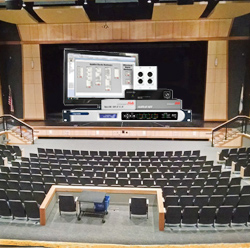1) For both fixed installation and live performance sound, clarity (loudspeaker optimization, alignment and delay) is paramount. For a live performance, one may want to be especially mindful of speaker protection – overall dynamics, limiting – and ear protection. A decent DSP system will have all the tools necessary for either deployment.
2) Go with the network protocol that is easiest to implement, offers the best support, meets technical requirements and works across the whole system. Many system designers may value third party participation and support. This is one area of technology where there is definitely strength in numbers.
3) To make a complex design feel simpler, only expose the optimized subset of control necessary for the intended user to operate the system. Also label controls clearly, and arrange them in a familiar manner.
4) Using copper, you can get 100 meters of audio distribution per switch hop. You can go longer distances (with fewer switches) by converting to fiber.
5) The secret of really good sound quality is to keep it simple – and don’t fight physics. There is no substitute for proper acoustic design, followed by system design.
6) Minimizing the number of tools required to perform a task is the best way of improving workflow for the integrator. And you can simplify those tasks by reducing the number of steps required to perform them, without locking out power features that may be required in fringe cases that can really save the day.
7) Remember the difference between Ethernet and IP: Ethernet is a collection of network technologies; IP encompasses a suite of protocols that travel over Ethernet networks.
8) Use the right interfaces – Wall panels are guaranteed points of control, so think of them as light switches. If a user absolutely has to be guaranteed to always have control over a certain aspect of the system from a certain physical place, that’s the best place for a dedicated wall panel. Desktop computers can handle more sophisticated system control aspects and are, typically, guaranteed to be in one place. Smartphones and laptops are more BYOD (bring your own device) points of control and should be considered more casual – they are not guaranteed to always be available for multiple users unless permanently installed somehow. They are good for ad-hoc and on-the-go control.
9) Any system capable of greater than 64 channels should be designed using components that can adequately handle such capacity and maintain the level of performance required by the application or user.
10) You can create a software app for every situation, but it may not be optimal. Software can be tailored for specific tasks or general use cases. When software is tailored for a specific task, it is generally quicker and easier to use for that task but may not be capable of handling other tasks outside of its intended scope. Conversely, when a piece of software is designed to handle anything, it may be able to do so but it can be cumbersome to use, difficult to learn and slow to accomplish certain tasks.
Dane Butcher founded DSP manufacturer Symetrix in 1976 and has guided the company through generational changes in signal processing technology for recording, broadcast and fixed installation.
















